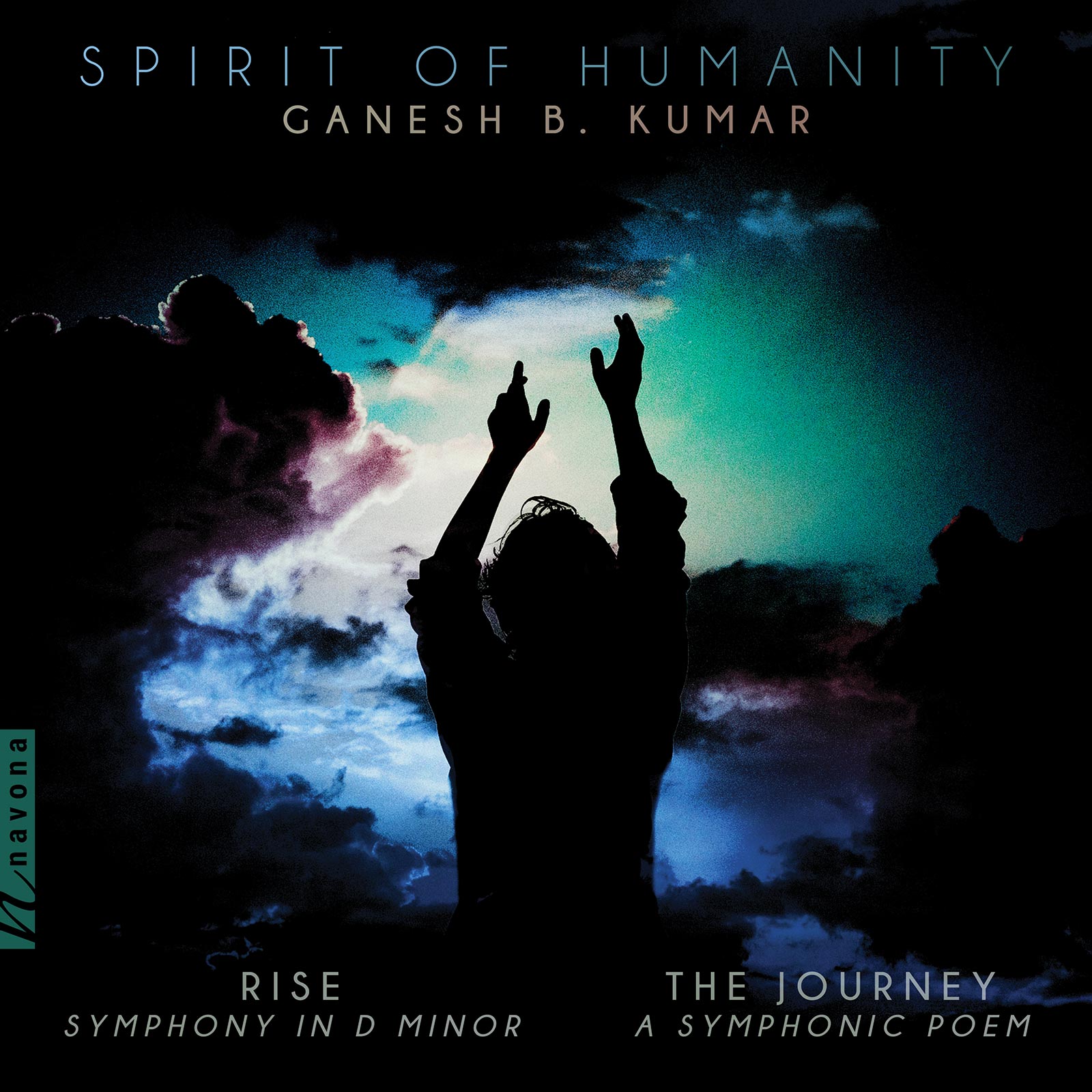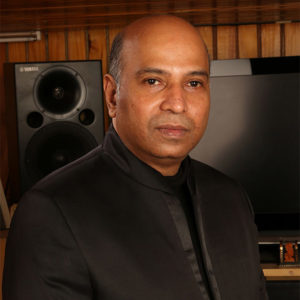
Share Album:
Spirit of Humanity
Ganesh B. Kumar composer
A historical feast awaits listeners on Ganesh Kumar's first NAVONA release SPIRIT OF HUMANITY. Half intended as an homage to Beethoven, half a musical portrayal of a little-known refugee crisis in World War II, it aims to be an epically emotional orchestral experience.
The distinctly Indian twist of SPIRIT OF HUMANITY is not only owed to Kumar's nationality, but also to the commissioner of the recorded works, the Dhahara Vidhya Foundation. Why Kumar would be asked to create Rise, a symphony inspired by Beethoven in time for the 250th birth anniversary of the great composer appears obvious. The piece draws heavily on Beethovian elements from the first measure to the last, and includes, among others, reminiscences of Beethoven's most popular themes, such as the opening motif of the composer's Fifth Symphony, but consciously introducing a rising figuration (as against the falling 3rds of the original) signifying positivity and perseverance.
Much less apparent, and thus perhaps more interesting, is the provenance of the other recorded work, The Journey – From Despair to Hope – A Symphonic Poem. This large piece of program music reminds the listener of the little-known, terrible hardships of Polish refugees in the early 1940's, when thousands of displaced Poles in Russia, owing to a great humanitarian act by Maharaj Jam Saheb Digvijay Singhji, embarked on an arduous journey to India, and found a new home in the then-princely Indian state of Nawanagar. Kumar's uncanny ability to paint the deprivation, depletion, and truculent perseverance of the refugees in stark tonal colors is nothing short of jaw-dropping; and the finale, an extolment of the Maharaj's generosity, vividly evokes satisfaction and relief in the face of suffering overcome. The symphonic poem makes a powerful case for pacifism on the 75th anniversary of the unconditional surrender of Nazi Germany, to the Allied forces in 1945, thereby ending World War II in Europe.
Finally, a bonus track rounds off the album with an a cappella Undaal Amma Ivvulagam in the Tamil language. This Indian ending is a fitting encore, considering that it is emotionally intense like the rest of SPIRIT OF HUMANITY – and, perhaps, like Ganesh Kumar himself.
Listen
Stream/Buy
Choose your platform
Performance Videos
Ganesh Kumar - Rise | Ganesh Kumar – The Journey
"A spellbinding work of collaboration"
Track Listing & Credits
| # | Title | Composer | Performer | |
|---|---|---|---|---|
| 01 | Rise: I. Allegro con brio | Ganesh B. Kumar | Staatskapelle Halle Orchestra | Bernd Ruf, conductor | 7:30 |
| 02 | Rise: II. Andante | Ganesh B. Kumar | Staatskapelle Halle Orchestra | Bernd Ruf, conductor | 7:47 |
| 03 | Rise: III. Allegro con moto | Ganesh B. Kumar | Staatskapelle Halle Orchestra | Bernd Ruf, conductor | 7:07 |
| 04 | The Journey | Ganesh B. Kumar | Staatskapelle Halle Orchestra | Bernd Ruf, conductor; Vocal Quartet | Jaqueline Zierau, soprano; Peggy Klemm, alto; Maik Gruchenberg, baritone; Matthias Schulze, bass; Choir of the Opera Halle | Markus Fischer, conductor | 26:12 |
| 05 | Undaal Amma Ivvulagam (A Capella Version) | Ganesh B. Kumar | Shalini Singh Balaji and Keshav Vinod Kumar - vocals | 2:42 |
RISE: SYMPHONY NO.1 IN D MINOR
Homage to Ludwig van Beethoven
THE JOURNEY - FROM DESPAIR TO HOPE: A SYMPHONIC POEM
Homage to ‘Maharaj’ Jam Saheb Digvijay Singhji
I. THE NIGHT BEFORE THE JOURNEY: ARIA I - LOST SOULS
Lyrics by Georgina Margarite Ezra
IX. THE WARM WELCOME: ARIA II: BAPU BAPU
Lyrics by Georgina Margarite Ezra | Choir of the Opera Halle
X. EXTOLLING THE VIRTUES OF THE MAHARAJ: ARIA III - UNDAAL AMMA IVVULAGAM
from Purananooru, a compilation of ancient Tamil verses, written by ‘Kadalul maaindha’ Ilamperuvazhudhi
I have no words to describe the depth of gratitude I feel for our patron Mr. Anand Madhavan, for his magnanimous generosity and unconditional support in realizing this musical venture.
— Ganesh B. Kumar
Live recordings produced by Dynamedion GbR
Recorded July 2 - 3, 2019 with 91 instrumentalists and 31 singers at the rehearsal hall of the Staatskapelle Halle in Halle (Saale), Germany
Session Manager Marcell Kelemen
Session Producer David Christiansen
Recording Producer Holger Busse, at GENUIN
Engineer Anne Taegert, at GENUIN
Audio Postproduction Holger Busse & Anna Taegert , at GENUIN
Producer Ganesh B. Kumar
CORE TEAM
Project lead Dr. Prem Venkatesh Ram Mohan
Chief linguistic consultant V. Muthukumaraguruswamy
Songwriter and translator Georgina Margarite Ezra
Concept and program notes Anand Madhavan
OUR SPECIAL THANKS TO
Ashok Ram Mohan
V. Muthukumaraguruswamy
Dr. Prem Venkatesh Ram Mohan
AMPA Palaniappan
R.Venkateshwaran
Balaji Rajagopallan
J. Lakshmi Narayanan
Rajan Ekambaram
Karthikeyan Ramaswamy
Executive Producer Bob Lord
Executive A&R Sam Renshaw
A&R Director Brandon MacNeil
A&R Jacob Smith
VP, Audio Production Jeff LeRoy
Audio Director, Addtl. Mastering Lucas Paquette
Addtl. Mastering Shaun Michaud
VP, Design & Marketing Brett Picknell
Art Director Ryan Harrison
Design Edward A. Fleming
Publicity Patrick Niland, Sara Warner
Artist Information

Ganesh B. Kumar
Ganesh B. Kumar L.T.C.L. is a music composer/producer from Chennai, India. He obtained his double Licentiate from the Trinity College of Music, London, under the tutelage of the renowned teacher Mr. Abdul Sattar. It was always his desire to compose music that would elevate the spirit of mankind. This goal has not changed to this day, and remains his standard of accomplishment as a composer.
Notes

The Staatskapelle Halle Orchestra, photo: Falk Wenzel


